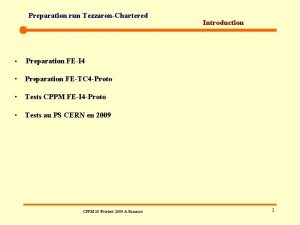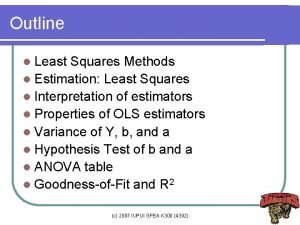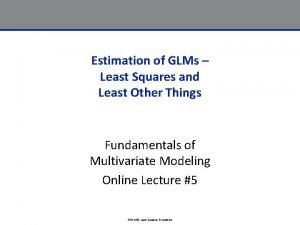Preparation for NS 2 4 Determine the least















- Slides: 15

Preparation for NS 2. 4 Determine the least common multiple and the greatest common divisor of whole numbers; use them to solve problems with fractions (e. g. to find a common denominator to add two fractions or to find the reduced form for a fraction).

Objective: We will identify 1 prime and composite numbers and represent 2 the prime factorization of composite numbers. 1 2 find show

Warm Up Write each number as a product of two whole numbers in as many ways as possible. 1. 16 2. 60 3. 36 1 16, 2 8, 4 4

A prime number is a whole number greater than 1 that has exactly two positive factors, 1 and itself. • 3 is a prime number because its only positive factors are 1 and 3. A composite number is a whole number that has more than two positive factors. • 6 is a composite number because it has more than two positive factors— 1, 2, 3, and 6

A composite number can be written as the product of its prime factors. This is called the prime factorization of the number. You can use a factor tree to find the prime factors of a composite number. Writing Mat

What is it called when a composite number is written as the product of it’s prime factors? Which shows an example of prime factorization? A. ) 3 3 5 2 B. ) 10 3 5

Check It Out! Example 1 Tell whether each number is prime or composite. A. 11 The positive factors of 11 are 1 and 11. B. 7 The positive factors of 7 are 1 and 7. 11 is prime. 7 is prime.

Check It Out! Example 1 Tell whether each number is prime or composite. A. 14 B. 16 The positive factors of 14 are 1, 2, 7, and 14. The positive factors of 16 are 1, 2, 4, 8, and 16. 14 is composite. 16 is composite.

1. Write your number as the product of 2 positive numbers. 2. Continue factoring until all the numbers are prime. 3. Circle the prime numbers. 4. You can write prime factorization by using exponents. The exponent tells how many times to use the base as a factor.

Additional Example 2 A: Using a Factor Tree to Find Prime Factorization Write the prime factorization of the number. 24 24 8 3 4 2 3 2 2 2 3 • Write 24 as the product of two positive factors. • Continue factoring until all factors are prime. • Circle your prime numbers • Write the prime factorization using exponents. The prime factorization of 24 is 2 2 2 3 or 23 3.

Additional Example 2 B: Using a Factor Tree to Find Prime Factorization Write the prime factorization of the number. 150 • Write 24 as the product of two positive factors. 30 5 • Continue factoring until all factors are prime. 10 3 5 • Circle your prime numbers 2 5 3 5 • Write the prime factorization using exponents. The prime factorization of 150 is 2 3 5 5, or 2 3 5 2.

Check It Out! Example 2 A Write the prime factorization of the number. 225 • Write 24 as the product of two positive factors. 225 45 5 9 5 5 3 3 5 5 • Continue factoring until all factors are prime. • Circle your prime numbers • Write the prime factorization using exponents. The prime factorization of 225 is 3 3 5 5, or 32 52.

Check It Out! Example 2 B Write the prime factorization of the number. 90 • Write 24 as the product of two positive factors. 90 45 2 9 5 2 3 3 5 2 • Continue factoring until all factors are prime. • Circle your prime numbers • Write the prime factorization using exponents. The prime factorization of 90 is 3 3 5 2, or 2 32 5.

Closure What is a number called that has only 2 positive factors? What is a number called that has more than 2 positive factors? What is it called when you write a composite number as the product of its prime factors? Is is prime or composite? 23 39 Write the prime factorization of the number 120

Lesson Quiz Tell whether each number is prime or composite. 1. 23 prime 2. 39 composite 3. 27 composite Write the prime factorization of each number. 4. 27 33 5. 36 22 32 6. 28 22 7 7. 132 22 3 11 8. 52 22 13 9. 108 22 33
 Humanitr
Humanitr Steg för steg rita
Steg för steg rita Debatt mall
Debatt mall Redogör för vad psykologi är
Redogör för vad psykologi är Bästa kameran för astrofoto
Bästa kameran för astrofoto En lathund för arbete med kontinuitetshantering
En lathund för arbete med kontinuitetshantering Geometriska former i förskolan
Geometriska former i förskolan Publik sektor
Publik sektor Dikt med rim
Dikt med rim Fredsgudinna pax
Fredsgudinna pax Orubbliga rättigheter
Orubbliga rättigheter Förklara densitet för barn
Förklara densitet för barn Ministerstyre för och nackdelar
Ministerstyre för och nackdelar Jätte råtta
Jätte råtta Verktyg för automatisering av utbetalningar
Verktyg för automatisering av utbetalningar Vad är hsil
Vad är hsil





























